You are using an out of date browser. It may not display this or other websites correctly.
You should upgrade or use an alternative browser.
You should upgrade or use an alternative browser.
Which Revolver would you recommend?
- Thread starter PatrickBateman
- Start date
Jack O'Conner
New member
Taurus is a very well crafted revolver. I'm pretty sure it's a S & W design built under a patent lease arrangement. Pricing is competitive.
Rossi makes a good revolver but finish is typically less quality than Taurus.
Jack
Rossi makes a good revolver but finish is typically less quality than Taurus.
Jack
lee n. field
New member
Taurus is a very well crafted revolver. I'm pretty sure it's a S & W design built under a patent lease arrangement. Pricing is competitive.
Not exactly, but never mind.
Call me old, but everyone's FIRST handgun should be a single action .22 LR revolver.
Why is that? Especially, why single action?
Very well KenW, you're old.Call me old, but everyone's FIRST handgun should be a single action .22 LR revolver.
While a single action has a certain appeal, it's ergonomics can be very different from a double-action. Whether that's good or bad probably varies from one person to the next. The first revolver I ever shot was a Ruger Blackhawk (single action). The plow grip never agreed with me (maybe a Bisley would be better). The first revolver I owned was a S&W 66 (double action), and it immediately felt like it was made for my hand.
Besides, most double action revolvers can be shot single action, but the opposite is obviously not true. And practicing shooting double action with improve your single action shooting more than shooting single action will improve your double action shooting.
As for going with the .22lr, i can see the logic--lower recoil, less noise, cheaper to shoot--but if you buy or load 38 specials at Cowboy Action levels, the recoil and noise aren't significantly greater. And with 22 ammo still picked over and higher priced, a reloader can shoot .38/357 with cast bullets for not a lot more than .22lr. He'll probably end up with a 38/357 anyway, and the $400+ spent on a decent .22 SA revolver will buy all the necessary reloading equipment and a bunch of factory ammo besides.
Also, by selecting a 38/357 in DA right away, you've got a gun that is already suitable for home defense, and you immediately get range time with a gun you may actually stake your life on.
Last edited:
anothernewb
New member
If you're not afraid to buy used. a S&W 19, S&W 66, or a 6 series ruger are all fantastic choices, as has been said.
In a NIB pistol, between the choices the OP originally stated. GP100 hands down.
Not that I'm bashing Taurus at all. My personal experience with Taurus has been positive, I have one chambered in 327 magnum that's a fine shooter - albeit a little heavy on the trigger. IMO, they make a fine firearm, but it seems the more I talk to people there's a lot of poorly made ones that hit the shelves too. Taurus will stand behind their units and warranty them out - but how much hassle do you want to go through to save a few bucks. by the time you make 3-4 trips back to the GS, you've already lost any advantage you've had.
In a NIB pistol, between the choices the OP originally stated. GP100 hands down.
Not that I'm bashing Taurus at all. My personal experience with Taurus has been positive, I have one chambered in 327 magnum that's a fine shooter - albeit a little heavy on the trigger. IMO, they make a fine firearm, but it seems the more I talk to people there's a lot of poorly made ones that hit the shelves too. Taurus will stand behind their units and warranty them out - but how much hassle do you want to go through to save a few bucks. by the time you make 3-4 trips back to the GS, you've already lost any advantage you've had.
On a budget...one of Ruger's offerings will probably be ok.../ I'd stay away from the Taurus offerings...(but just my opinion )...
but the S&W's are better guns in my opinion than the Rugers as well ( look for a model 66 (stainless) or a model 19 ( blued )...both K frames...)/ or the L frame ( model 686 )...or maybe a used model 28 ( N frame )..../ you should find some guns between $ 650 - $ 800...
and personally I like the 4" in an all around gun - especially if I want to carry it concealed / a 6" is fine for a bedside gun or a range gun...
but the S&W's are better guns in my opinion than the Rugers as well ( look for a model 66 (stainless) or a model 19 ( blued )...both K frames...)/ or the L frame ( model 686 )...or maybe a used model 28 ( N frame )..../ you should find some guns between $ 650 - $ 800...
and personally I like the 4" in an all around gun - especially if I want to carry it concealed / a 6" is fine for a bedside gun or a range gun...
What is the budget? That will help us help you.
Ruger would be my pick if you are on a budget. Built like a tank and will out last all of us. Not as refined as a S&W but a good solid gun that once you have it will always be welcome in the safe.
I also would not rule out a used S&W.
Ruger would be my pick if you are on a budget. Built like a tank and will out last all of us. Not as refined as a S&W but a good solid gun that once you have it will always be welcome in the safe.
I also would not rule out a used S&W.
PatientWolf
New member
+1 on the S&W 686, 586 or 66 used.
For a new, if you can't afford a S&W:
If you want 6 shots, I'd recommend the GP 100 with a...wait for it... 5" barrel.
Better sight radius than a 4" and more compact than a 6".
If you think 5 shots would be acceptable, you could consider an SP 101. A 3" barrel would make it more concealable.
For a new, if you can't afford a S&W:
If you want 6 shots, I'd recommend the GP 100 with a...wait for it... 5" barrel.
Better sight radius than a 4" and more compact than a 6".
If you think 5 shots would be acceptable, you could consider an SP 101. A 3" barrel would make it more concealable.
Ruger; GP100; 4 inch barrel. And a set of hearing protection that you can toss on at the same time, preferably the electronic type. I like the looks of blued, plus it's a tad bit cheaper.
4 inch and longer barrels start to make use of the power of the .357 magnum. Starting out with .38's to begin with; perhaps, but I started with a .357 and only considered .38's to teach the wife. 3 and 4 inch barrels tend to be more proportioned and balanced than longer barrels do. I like 6 inch barrels for target practice, and that also might work well for hunting.. I think 4 inch is a nice carry size; a balance of the power and how it feels.
Hearing protection: No matter what caliber you fire, I don't think anyone will find shooting in a house (indoors) to be peaceful and comfortable. Sure, you could choose a .22LR, but even then, it's not going to be nice to your hearing indoors either. Want proof? Go to an indoor shooting range on a light day, take a .22LR pistol, and pull your muffs off and shoot. Besides, if the other party breaking into your house is packing a 9mm or .38, your decision to use a .22LR because of your hearing is moot anyways; the bad guy's 9mm or .38 is gonna reverberate and you will want some hearing protection anyhow. So, personally, I'd choose a gun that I can shoot well, and plan on using hearing protection! Otherwise, if anyone fires a shot, it's going to not be pleasant, even for your hearing.. Same thing goes for suppressors; I hear where some folks think that suppressors negate the need for hearing protection; what if the bad guy brings a gun and starts shooting inside; how will that suppressor help your hearing ? Hearing protection! And get the gun that can stop the bad guy ! When I point and or fire my gun at the bad guy, I want him to be thinking "Damn, wrong house! " Don't get me wrong, I keep a .22LR for a backup every now and then.. But when it comes to defense, I prefer 9mm and .357 Magnum.
4 inch and longer barrels start to make use of the power of the .357 magnum. Starting out with .38's to begin with; perhaps, but I started with a .357 and only considered .38's to teach the wife. 3 and 4 inch barrels tend to be more proportioned and balanced than longer barrels do. I like 6 inch barrels for target practice, and that also might work well for hunting.. I think 4 inch is a nice carry size; a balance of the power and how it feels.
Hearing protection: No matter what caliber you fire, I don't think anyone will find shooting in a house (indoors) to be peaceful and comfortable. Sure, you could choose a .22LR, but even then, it's not going to be nice to your hearing indoors either. Want proof? Go to an indoor shooting range on a light day, take a .22LR pistol, and pull your muffs off and shoot. Besides, if the other party breaking into your house is packing a 9mm or .38, your decision to use a .22LR because of your hearing is moot anyways; the bad guy's 9mm or .38 is gonna reverberate and you will want some hearing protection anyhow. So, personally, I'd choose a gun that I can shoot well, and plan on using hearing protection! Otherwise, if anyone fires a shot, it's going to not be pleasant, even for your hearing.. Same thing goes for suppressors; I hear where some folks think that suppressors negate the need for hearing protection; what if the bad guy brings a gun and starts shooting inside; how will that suppressor help your hearing ? Hearing protection! And get the gun that can stop the bad guy ! When I point and or fire my gun at the bad guy, I want him to be thinking "Damn, wrong house! " Don't get me wrong, I keep a .22LR for a backup every now and then.. But when it comes to defense, I prefer 9mm and .357 Magnum.
I'm pretty close to purchasing my first handgun, and was leaning towards a Semi-auto, but I've always had a love for revolvers, and am strongly considering getting one as my first gun.
Don't do it.
Learning to shoot one at speed and quickly reload is more difficult than a semi-auto. I know they're neat, but semi-autos are easier to deal with in a fighting role. Competent revolver instructors are becoming difficult to find and it's quite important that you train with one.
I prefer revolvers chambered in 357 Magnum for defense because it's very common and easier to shoot. 357 Magnum has enough recoil to fight and the 44 calibers can be too much. 38 Special works in them. It recoils and costs less, which is good for training up to 357 Magnum. If you only have 6-8 rounds in a full size revolver, make them magnums! If the revolver is small, use 38 Special--but that's not the gun for you.
Now, that said, if you're willing to take the challenge, then go for it.
Don't even think of getting a snubby. The minimum barrel length for learning to shoot a revolver fast and accurately is four inches. Five is good too, but more difficult to conceal. Six is great for the range and open carry, but not so good under a shirt in an IWB holster. Just stick with a gun with a four inch barrel and you'll be fine.
But keep in mind that you'll need to be more diligent in your training schedule. You'll need to dry fire and practice reloading frequently. Buy a cartridge tray and at least six Safariland Comp 1 or 2 loaders. Carry them in the Safariland Split Six holder.
Shooting 22 Long Rifle will teach you about pulling the trigger, but not managing recoil. Make sure to shoot plenty of centerfire ammunition. You'll need to learn trigger reset under recoil; this book will help with this along with other revolver shooting topics:
The Gun Digest Book of the Revolver
Also read No Second Place Winner since it's still relevant. Bill Jordan also recommends against the 44 calibers, yet strangely promotes 41 Magnum (which I found just as bad) while still recommending 357 Magnum.
Overall, though, the semi-auto is more concealable, trainers are far more available, and they're easier to shoot.
Ruger GP100 in Milt Sparks Versa Max 2. The trigger on this example was great out the box. Try different ones until you find one with a sweet trigger. This is "just right" for personal defense and is the "winner" of the Tom RKBA Carry Contest.
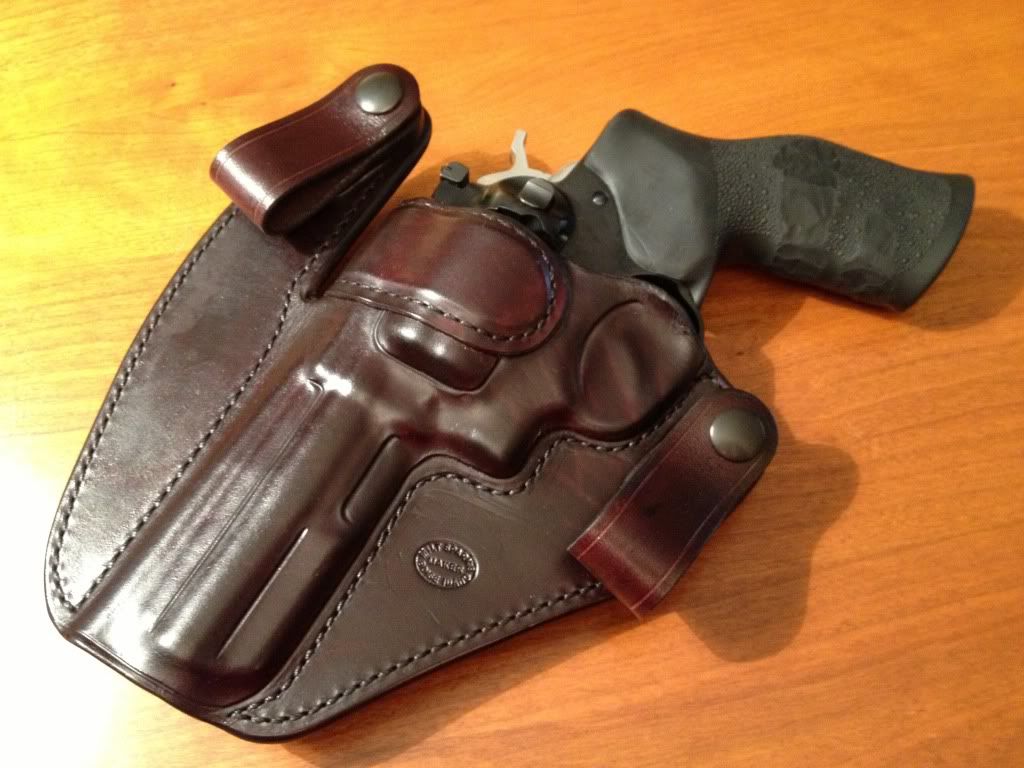
S&W Model 58 in 41 Magnum. Looks great, hard to shoot. Needs better sights.

S&W Model 19 with 2 1/2" barrel. Lots of people love these, but I hated it. It was hard to shoot at speed with 357 Magnum and the training time wasn't worth it. It's the same size as a Glock 19, but has none of the Glock 19's advantages.

Ruger Alaskan in 44 Magnum. It's a great gun for 44 Special, but it's a bit large at 54 ounces. It needed boot grips and night sights. Yes, I carried it in the appendix position.
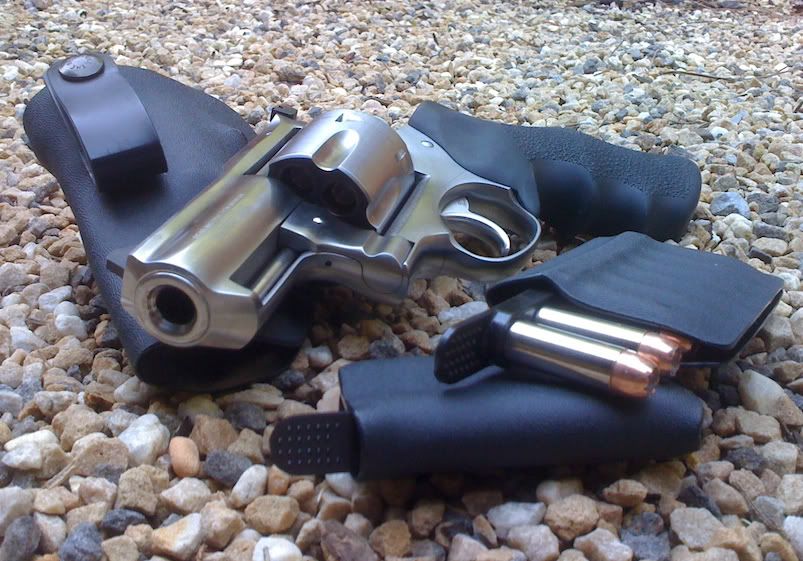
S&W Model 442. The only thing good to say about this revolver is that it's small and fits in a coat pocket in a DeSantis Nemesis. It's terrible to shoot and needs many upgrades to make it shoot as poorly as the S&W Model 19.
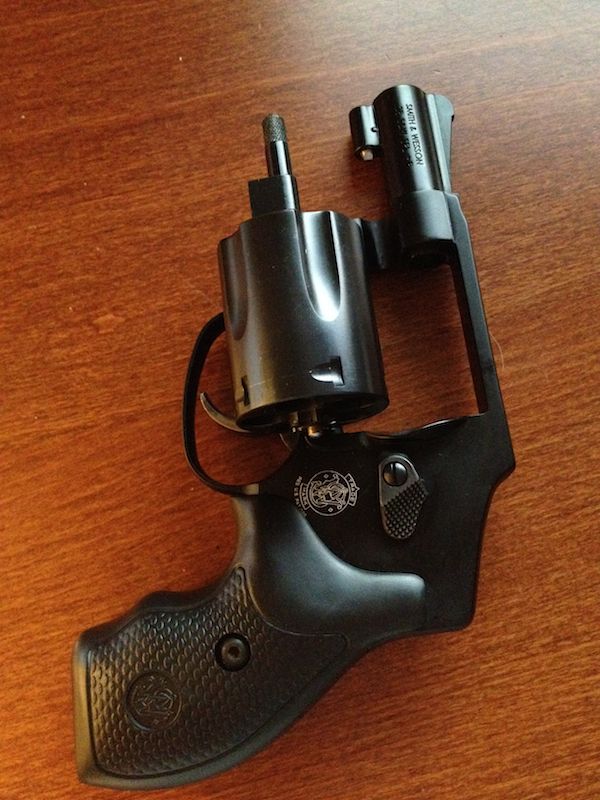
S&W Model 24 with 3" barrel. This is my favorite gun to not shoot. I had night sights installed and the charge holes chamfered. I added Herrett's Stocks' Jordan Trooper stocks for carry. I don't carry it because 44 Special is too much for the reasons outlined in No Second Place Winner. It lives in my gun safe.
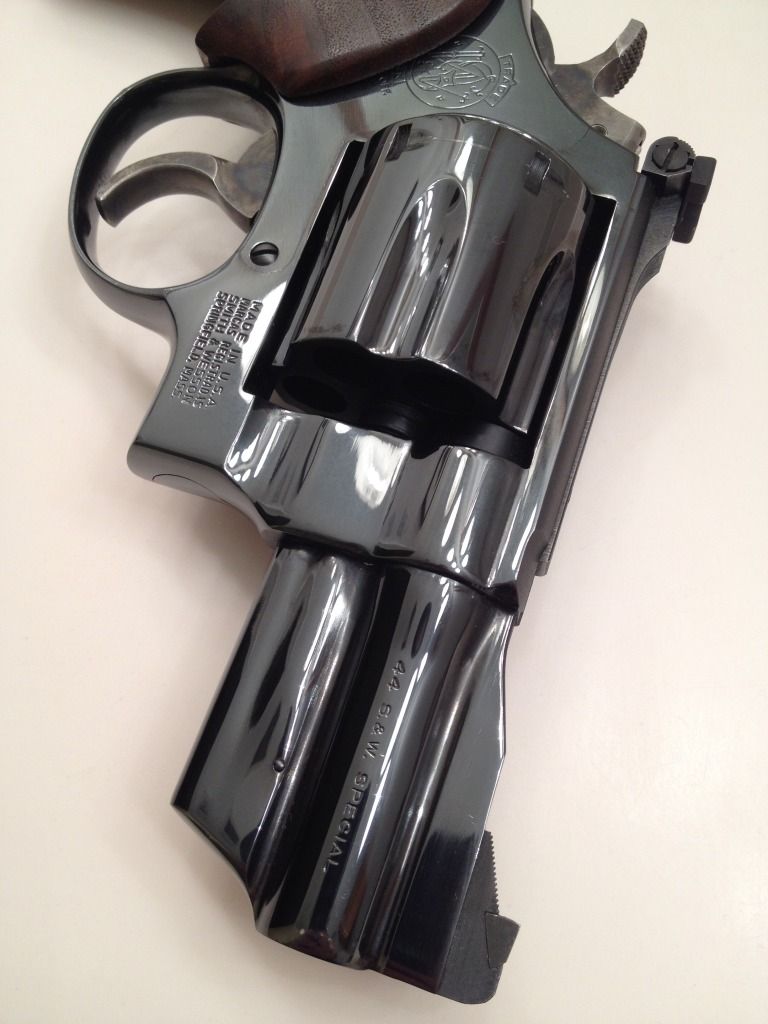
Last edited:
These are the essential features you should look for:
1) Round butt (S&W). Rugers have a small stub that holds the grips on, so you want shorter grips. They should still support the palm and you should be able to get your small finger on it. Go with a boot grip once you know what you are doing.
2) Pinned front sight. You should be able to easily replace the front sight with a night sight. Adjustable sights on S&W and Ruger revolvers can be replaced with night sights too.
3) Chamfered charge holes. These are small cuts on the cylinder to aid in the loading of cartridges. You will notice your cartridge noses "sticking" rather than "flowing" when the edge of the hole is not beveled. A gunsmith will have to do this for you if the gun doesn't have it out of the box (a few S&W Performance Center guns have it).
4) Good trigger. The trigger weight BOTH ways is important. The return speed of the trigger determines the speed of the next shot. If it's too slow, your trigger finger will outrun it and tend to slap the next shot. If it's too fast, it's too heavy and affects the pull. Read about it in The Gun Digest Book of the Revolver by Grant Cunningham.
Notice the slight bevel on the edges of the holes.
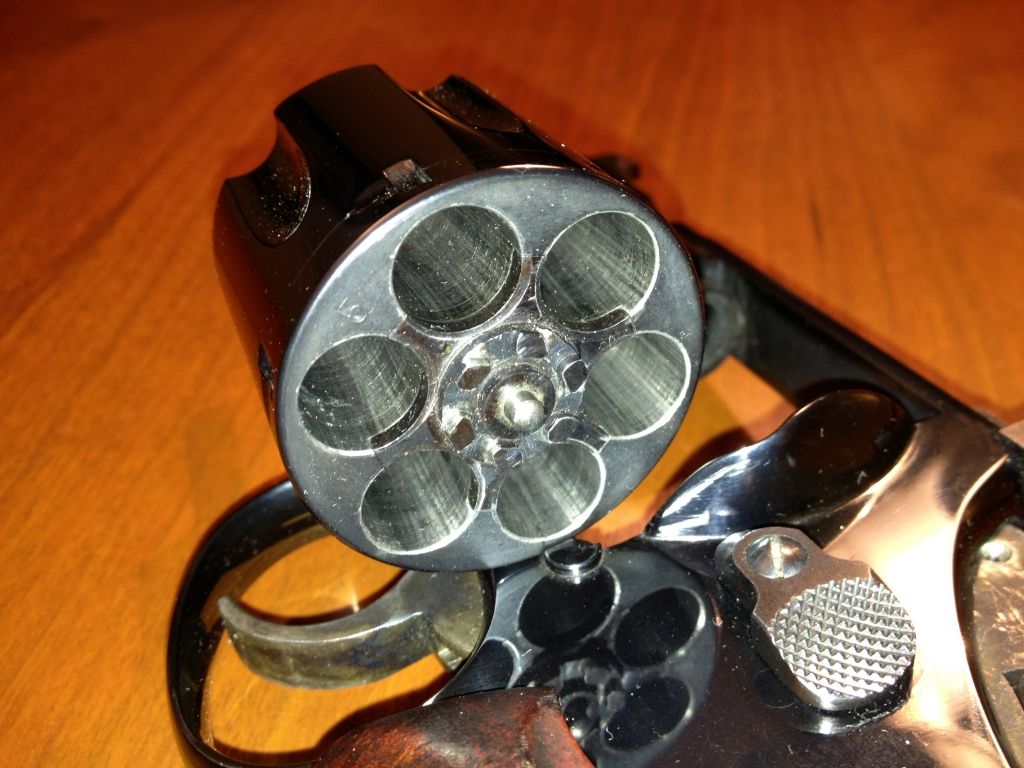
S&W 327 TRR8. Awesome shooter and holds eight rounds of 357 Magnum. The two piece barrel soaks up recoil and the 5" barrel makes it very accurate. The front sight is easily replaced with a night sight. I would carry it daily if it had a four inch barrel, boot grips and if I could hide the loaders. I'd put a Trijicon RMR on the top rail (not shown) if it didn't make the entire package too large. The speed loaders are nearly impossible to hide on the belt or pocket.
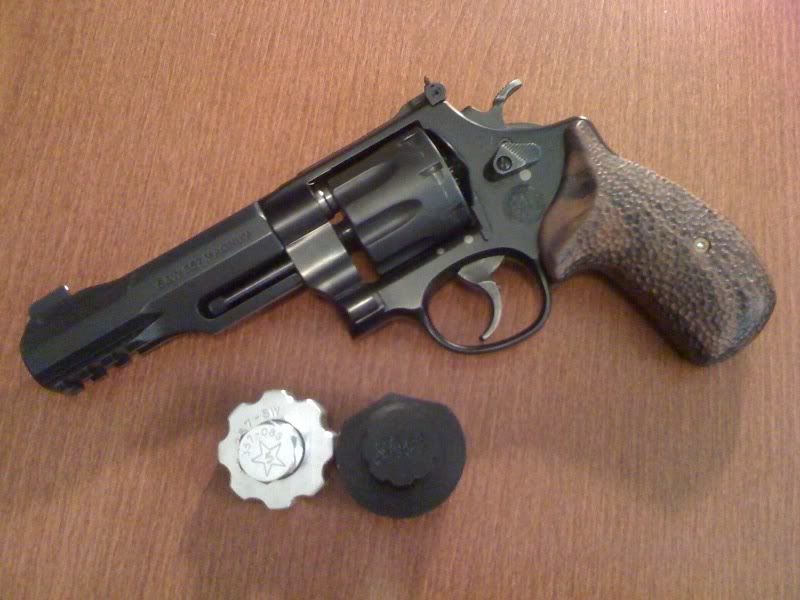
S&W 625 in 45 ACP. This is another great carry gun, but the 327 TRR8 shoots better. The 45 ACP cartridge works well with the steel frame. Hiding moonclips is not difficult, but getting good holders is nearly impossible. I built my own. These N-Frames require larger shirts to hide than for a gun in 357 Magnum on a smaller gun frame. I shot a friend's S&W 325 in 45 ACP and the recoil was too stout. The weight of the steel frame makes for fast shooting. Carrying the 625 is only 3/4 of the insanity of carrying a Ruger Alaskan in the appendix position.
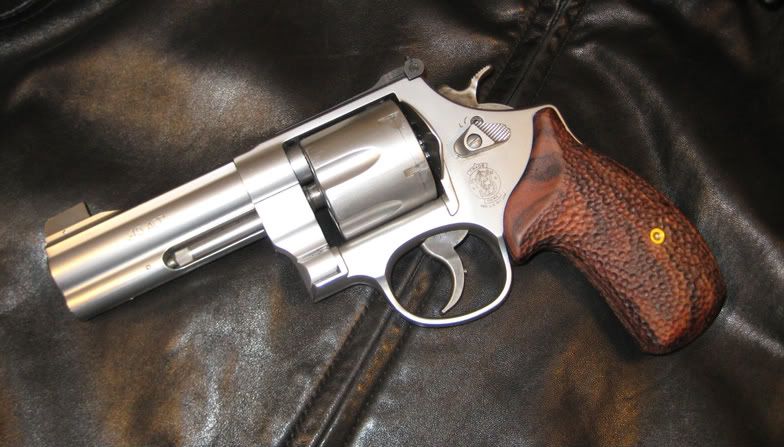
1) Round butt (S&W). Rugers have a small stub that holds the grips on, so you want shorter grips. They should still support the palm and you should be able to get your small finger on it. Go with a boot grip once you know what you are doing.
2) Pinned front sight. You should be able to easily replace the front sight with a night sight. Adjustable sights on S&W and Ruger revolvers can be replaced with night sights too.
3) Chamfered charge holes. These are small cuts on the cylinder to aid in the loading of cartridges. You will notice your cartridge noses "sticking" rather than "flowing" when the edge of the hole is not beveled. A gunsmith will have to do this for you if the gun doesn't have it out of the box (a few S&W Performance Center guns have it).
4) Good trigger. The trigger weight BOTH ways is important. The return speed of the trigger determines the speed of the next shot. If it's too slow, your trigger finger will outrun it and tend to slap the next shot. If it's too fast, it's too heavy and affects the pull. Read about it in The Gun Digest Book of the Revolver by Grant Cunningham.
Notice the slight bevel on the edges of the holes.

S&W 327 TRR8. Awesome shooter and holds eight rounds of 357 Magnum. The two piece barrel soaks up recoil and the 5" barrel makes it very accurate. The front sight is easily replaced with a night sight. I would carry it daily if it had a four inch barrel, boot grips and if I could hide the loaders. I'd put a Trijicon RMR on the top rail (not shown) if it didn't make the entire package too large. The speed loaders are nearly impossible to hide on the belt or pocket.

S&W 625 in 45 ACP. This is another great carry gun, but the 327 TRR8 shoots better. The 45 ACP cartridge works well with the steel frame. Hiding moonclips is not difficult, but getting good holders is nearly impossible. I built my own. These N-Frames require larger shirts to hide than for a gun in 357 Magnum on a smaller gun frame. I shot a friend's S&W 325 in 45 ACP and the recoil was too stout. The weight of the steel frame makes for fast shooting. Carrying the 625 is only 3/4 of the insanity of carrying a Ruger Alaskan in the appendix position.

Last edited:
Honestly, if I wanted a good revolver, off the shelf for HD and some occasional CCW, I would get a pre-lock S&W K frame from the late 70's or 80's.
Something like a 3" or 4" 13,19,65,66.....they can be had for $450-$600 in good shootable condition. I think I'm into my blues 19 for about $500. It was in great shape finish and wear wise. An ugly one should be ~$350....off to the smith for check out and Cerakote should be under $350.
Something like a 3" or 4" 13,19,65,66.....they can be had for $450-$600 in good shootable condition. I think I'm into my blues 19 for about $500. It was in great shape finish and wear wise. An ugly one should be ~$350....off to the smith for check out and Cerakote should be under $350.
One other thing...
The caliber you choose not withstanding, you'll want to investigate a modest outlay of funds to begin reloading your own ammo. It will make the necessarily frequent practice more affordable, and can be used to tame recoil, if you buy one of the .41 - .45 caliber revolvers (for the .357, one need only use .38s).
I've never read No Second Place Winner, so I don't have the entire story on what Mr. Jordan's objections to the large-bore revolvers consist of. If recoil is the issue, then all of these rounds may be loaded to 100 f/s lower muzzle velocity, until the shooter is well and truly grounded in basic skills. The difference in recoil on the shooter's end will be noticeable, the difference in stopping power on the other end will not, unless shooting animals.
A .44 Mag may be loaded with .44 Specials, but they can be difficult to find, and expensive when available. At one time, Remington made a .41 Mag load that had an advertised velocity of 950 f/s with a 210 grain SWC. In 35 years, I have seen 2 boxes for sale, anywhere. A revolver in .45 A.C.P. may be shot with 185 grain target wadcutter loads for recoil reduction, but availability and price remain an issue.
Buying a revolver in .357 may forestall the need to become a reloader, but will likely never fully negate it.
The caliber you choose not withstanding, you'll want to investigate a modest outlay of funds to begin reloading your own ammo. It will make the necessarily frequent practice more affordable, and can be used to tame recoil, if you buy one of the .41 - .45 caliber revolvers (for the .357, one need only use .38s).
I've never read No Second Place Winner, so I don't have the entire story on what Mr. Jordan's objections to the large-bore revolvers consist of. If recoil is the issue, then all of these rounds may be loaded to 100 f/s lower muzzle velocity, until the shooter is well and truly grounded in basic skills. The difference in recoil on the shooter's end will be noticeable, the difference in stopping power on the other end will not, unless shooting animals.
A .44 Mag may be loaded with .44 Specials, but they can be difficult to find, and expensive when available. At one time, Remington made a .41 Mag load that had an advertised velocity of 950 f/s with a 210 grain SWC. In 35 years, I have seen 2 boxes for sale, anywhere. A revolver in .45 A.C.P. may be shot with 185 grain target wadcutter loads for recoil reduction, but availability and price remain an issue.
Buying a revolver in .357 may forestall the need to become a reloader, but will likely never fully negate it.
trapper9260
New member
I say also for the first gun and to get use to it and use it like the OP stated ,I say the 357mag BH ,that was my first centerfire hand gun and still have it also.After one get use to shooting it then like if you have only one round you want to load and it is dark ,You have the gun empty and need to get that one round in but need to see what cylider it is set at.I found on the SA is that you count how many clicks for you to then pull the hammer back and then when you squeeze that trigger you will be shooting that one round.That is what I do when I run with a single six 22lr. 4 clicks and pull the hammer and I am at that one round.I do the same with my BH in 357 and I have a 327 that take 6 clicks since it is a 8 shot.Hope this will help some .
I would suggest a .22 SA revolver for a young person who needs instruction, as an SA is safer and has a heavier trigger pull, but an older person (old enough to be buying the gun himself) should be able to go with anything he chooses.
(Some folks might object to the "heavier trigger pull" for a beginner. But I knew a guy who was teaching his girl friend to shoot, using his High Standard
Olympic. After the first shot, she turned, pointed the gun right between his eyes, and sweetly asked, "What do I do to make it shoot again?" Not the time for a 2 pound trigger pull.)
Jim
(Some folks might object to the "heavier trigger pull" for a beginner. But I knew a guy who was teaching his girl friend to shoot, using his High Standard
Olympic. After the first shot, she turned, pointed the gun right between his eyes, and sweetly asked, "What do I do to make it shoot again?" Not the time for a 2 pound trigger pull.)
Jim
Patents only last 20 years. After than, anyone can copy the patented item without royalties or consideration. Also, if you take the side-plate off a Taurus 85 for instance, you will see that they are not to typical S&W design complete with rebound slide...they have a rod with a spring riding over it. The only thing relative to a S&W, is the S&W type of dished cylinder release and the patent certainly expired on those years ago.Taurus is a very well crafted revolver. I'm pretty sure it's a S & W design built under a patent lease arrangement. Pricing is competitive.
